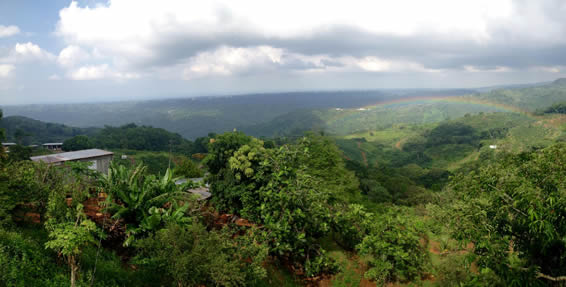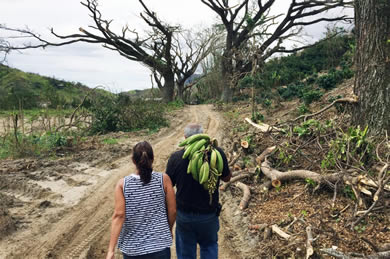GROW BIOINTENSIVE in the Aftermath of Hurricane María
Somewhere, 102 km from the urban center of San Juan, past the cerulean waters of Puerto Rico's northern coast, beyond the vast furrow of the central karst mountains, four months after the passing of Hurricane María, a yautia [Xanthosoma] plant emerges from dense red clay subsoil. This is the land where my great grandparents planted roughly five cuerdas (a cuerda is approximately .97 of an acre.) of coffee trees, sugar cane, plantain, and countless fruiting trees, and where, decades later, an old yautia seed would be reborn in an unexpected path. I have the great privilege of being able to live and work on these five cuerdas of land that have been in my family for three generations, land that prior to notions of private property and ownership were tended by my ancestors, Taino peoples of Borikén (Puerto Rico). Growing up witnessing the abundance of delicious tropical foods that the land can offer, I, like many of my peers, was frustrated by the exorbitant amount of imported food making it into Puerto Rican supermarkets and onto dinner tables, most of which could be grown in the rich, diverse soils of the island during its year-round growing season. When Hurricane María swept over Puerto Rico, amidst countless, seemingly uncountable deaths, catastrophic flooding and landslides, and an overall apocalyptic veil over the so-called Free Associated State, the vast majority of Puerto Ricans lost reliable access to food. Because of massive crop failure, and the fact that on average, ninety-five percent of food in Puerto Rican markets is imported, the people were at a loss. Puerto Rico's agricultural potential remains largely untapped. A comprehensive publication explores the fact that potential working lands, meaning lands well-suited for both mechanized and non-mechanized agriculture, encompass 42 percent of Puerto Rico's land area. Yet, only 22 percent of total land area, or 1977 square kilometers, is actively being farmed or pastured. According to an NPR article, every acre of arable land on the island has the potential to be as much as three times more productive than any corresponding acre in the United States, making it curious that you are more likely to find eggs imported from Vermont, corn from the American Midwest, and batata from Costa Rica than anything homegrown at the local supermarket. In part, this can be traced to the Jones Act, American farming subsidies, as well as cheap labor in developing countries. Moreover, only three percent of employed people in Puerto Rico are working in the agricultural sector, and not even half a percent of total female employment is in farming. The fact that such a small number of the Puerto Rican populace is dedicated to farming could be connected to a wide-scale social project taking place in the 1940s, Operation Bootstrap, designed by the US government to move Puerto Ricans out of the countryside, shifting them into the urban, industrial sector to produce material goods, especially textile and garment production. A consequence of Operation Bootstrap caused fertile agricultural land, much of it previously dedicated to sugar cane cultivation, to lie fallow, while farming and the Jibaro (traditional Puerto Rican famers) identity were rendered obsolete and "low-class". In fact, even before the hurricane, 83 percent of the island's farms were smaller than 50 cuerdas (48 acres), and abandoned family farms were all too common. For a time, it felt as if my family's farm was on the brink of contributing to that statistic. Since my great grandparents passed, more than half of the growing area they established was lost to a thicket of wild grasses. The river at its basin became clogged by the spread of Climbing Dayflower (Commelina diffusa), greatly affecting the rest of the watershed. Their son, my grandfather, a physician in the San Juan metro area, was spread thin commuting every weekend just to keep things afloat. Next in line is my mother's generation, who overwhelmingly made new lives in the United States—among the 5.1 million Puerto Ricans living in the US, the median age of island-born Puerto Ricans is 47 years. Despite the lack of tending, and later, a category-five hurricane, the fruiting trees and bushes planted and tended by my great grandfather recovered somewhat after four months, more so after a year: papaya, acerola cherry, grapefruit, pomarosa, and the kind of mango that, picked ripe, is seemingly more delicious devoured—never neatly sliced. Eventually, there was just enough substrate for the yautia to come around, roots finding a safe haven in the deep soil; so did the yuca (Manihot esculenta) and malanga (Colocasia). My grandfather hired locals to replant banana and plantain, among other staples my family brings from the countryside to their home in San Juan. Two things become apparent: For one, the land has the miraculous ability to heal itself. Second, it is in the hands of the millennial generation [aged between 22 and 36 as of 2018] to not only salvage abandoned land and become stewards of family lands, but also, to mediate the effects of Hurricane María and learn to flourish in a world where tropical storms are projected to only increase in occurrence and intensity. The effects of Hurricane María brought to light the long-standing food security and food sovereignty crisis in Puerto Rico. Agroecología, meaning an ecological way of managing agricultural and forest systems, had already explored this vulnerability and spread its teachings throughout the organic farming enclaves on the island. The work of Boricuá, El Josco Bravo, Plenitud, Siembra Tres Vidas, and many others has been integral in both rooting and refreshing the movement. Before the hurricane, brigadas, a contextually relevant model of bringing multiple farmers together for collaborative projects, were already taking place since the 1970s. But when the hurricane decimated so many farms' seed stock, Boricuá mobilized to put quality heirloom seeds from their collection directly in the hands of farmers across Puerto Rico. Siembra Tres Vidas made a distinguished effort to organize in their community of Aibonito, rebuilding people's homes, and helping establish the community food hub that provided food and dinners for people in need. The University of Puerto Rico, Utuado horticulture and farming program is promising, too. Every year, a handful of young farmers emerge equipped to hit the land. If anything, the crisis brought many more people together to rethink how to feed themselves and their communities. The GROW BIOINTENSIVE method has great potential in the Caribbean, encouraging a much needed closed-loop system in designing a garden on limited land area. Double- and triple-digging while incorporating quality, home-grown compost has already been shown to radically improve soil structure. This practice, combined with intensive and companion planting, will eventually capture carbon from the atmosphere and increase crop yields, as has been demonstrated at a Biointensive site in Veracruz, Mexico, Bosque de Niebla, whose climate is similar to that of mountainous Puerto Rico. While the teachings of Agroecología are spreading throughout the island, GROW BIOINTENSIVE would complement the movement by offering a data-driven approach to growing a nutritionally complete diet as well as offering opportunities for collaboration through a worldwide network of farmers and gardeners, including ECOPOL, the Latin-American stronghold for Biointensive agriculture. Ecology Action's tight methodology and global presence particularly resonated with me, and after completing the Three-Day GROW BIOINTENSIVE Workshop in Willits, CA, in 2018, I decided to pursue the 8-Month Internship on the more humid Mendocino coast. Within the scope of five years, as a caretaker of my ancestral land, I hope to have taken the skills and connections gained from an 8-Month Internship to ultimately rehabilitate the land and watershed; build rich, resilient soil; become mostly self-sustainable in reducing all imported soil inputs; grow a nutritionally complete diet for my family, community, and self; create an extensive seed library, and connect with a larger network of Biointensive, agroecological farmers and gardeners in the Caribbean and beyond, especially through seed exchange. I dream of creating a network of farmers that form a collective seed bank and support network through work parties and community dinners. One of our aims should be to integrate youth participation, and ultimately, feed central Puerto Rico, thereby increasing the sovereignty of the region. I share, along with my peers, the dream of a food-sovereign rural Puerto Rico. Months after such limited connectivity, from spotty cell service to the widespread lack of electricity on the island, I was able to reach my grandparents in San Juan. We talked about my new life in Northern California, about their waiting in line all day to get diesel to power their generator, and finally the conversation came to the farm. Reluctantly, I asked my grandfather how things were growing back. "The farm has seen better days," he said, "but it's doing alright." Like a yautia plant, the land finds its way. About yautia
top | Newsletter Home |Table of Contents| Archive
|




